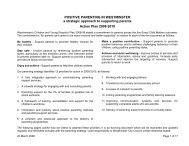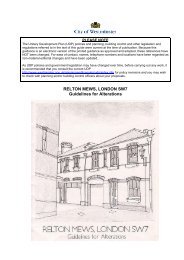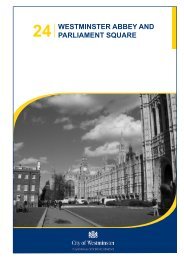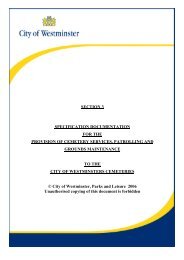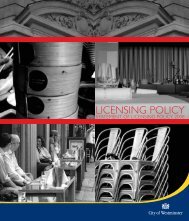Westminster Open Spaces Noise Study 2008 Final Report
Westminster Open Spaces Noise Study 2008 Final Report
Westminster Open Spaces Noise Study 2008 Final Report
- No tags were found...
You also want an ePaper? Increase the reach of your titles
YUMPU automatically turns print PDFs into web optimized ePapers that Google loves.
<strong>Westminster</strong> <strong>Open</strong> <strong>Spaces</strong> <strong>Noise</strong><strong>Study</strong> <strong>2008</strong>: <strong>Final</strong> <strong>Report</strong>Figure 12. Comparison of measured noise level predicted noise level from Defra ENDroad noise mapsPredictedLdenhigherDifference Between<strong>Noise</strong> map predicted L den andMeasured L Aeq,T (dB)1050-5-10Site adjacent to main roadSite not adjacent to main roadMeasuredL Aeqhigher-15Inigo Jones GardensPaddington RecreationWestbourne Estate CanalsideGolden SquareWestbourne GardensEbury SquareSoho SquareLeicester Square GardensVictoria Tower Gardens NorthSt Mary'sSt James's Park - Central AreaHyde Park - Central AreaRegents Park - EdgeTrafalgar SquareRegents Park - Central AreaLower GrosvenorSt James's Park - Edge (10 mins only)Harrow RoadRiverside WalkSt Anne'sHyde Park -Edge (near café)Paddington centralHyde Park -Edge (The Rose Garden)Hyde Park Corner War Memorial (5 mins only)5.3.5 From these results, it can be seen that the sites adjacent to main roads generally havehigher predicted L den noise levels from the noise maps than the measured L Aeq values. It islikely that this is due to the difference between these two noise indicators, and in particularthe contribution of night time noise levels to the L den indicator. Due to the definition of theL den noise indicator, in areas where noise levels do not decrease by at least 10 dB at night,the L den noise level will be greater than the daytime L Aeq level. This is likely to be the case inthe majority of central London locations, where data from previous noise studies 4,5 indicatethat a drop in noise levels of this magnitude is less common.5.3.6 Similarly, for the sites which are not adjacent to main roads, the measured noise levelsgenerally exceed the predicted values from the noise maps. In this case, a likelyexplanation is the contribution of noise sources other than the roads included in the noisemaps.5.4 Findings from Attitudinal Surveys5.4.1 Table 5 below summarises the assessment of the 20 given sites using the Toolkitdeveloped, as described above:D121316/R1/0227Scott Wilson LtdMarch 2009





